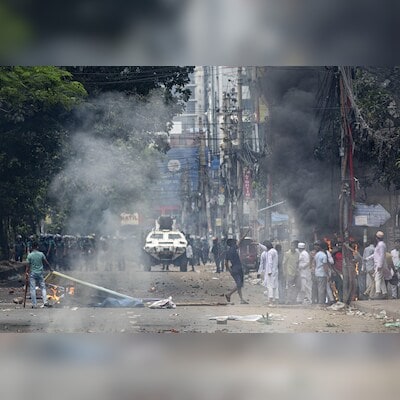)
Students clash with police during a protest over the quota system in public service, in Dhaka, Bangladesh, Friday, July 19, 2024. (Photo: PTI)
Emerging from the 1971 war, Bangladesh has been recently engulfed in protests that culminated in Hasina’s resignation. The announcement came as Army Chief General Waqar-uz-Zaman declared, “I’m taking all responsibility (of the country). Please cooperate,” as Hasina departed the country.
Sheikh Hasina, aged 76 and the daughter of Bangladesh’s founder Sheikh Mujibur Rahman, has been at the helm of the strategically vital South Asian nation since 2009. She secured her fourth consecutive term and fifth overall during the 12th general election in January this year, an election boycotted by the main opposition party, the Bangladesh Nationalist Party (BNP) led by former premier Khaleda Zia, along with its allies.
Over the last two days, more than 100 people have lost their lives in the protests against Hasina’s administration. The fierce demonstrations were fuelled by a controversial quota system for families of veterans of the 1971 liberation war.
Spate of assassinations after Bangladesh’s liberation
In 1975, Sheikh Mujibur Rahman, the nation’s first Prime Minister and Hasina’s father, was assassinated in a military coup, along with most of his family. This coup initiated a prolonged period of military rule. Sheikh Mujibur Rahman initially became the prime minister and later assumed the presidency in January 1975, implementing a one-party system.
Within a year, on August 15, he was assassinated by soldiers, along with his wife and three sons. Khondaker Mostaq Ahmad, supported by part of the army, then seized power.
The same year saw two more coups, ending with General Ziaur Rahman assuming control in November. Ahmad’s brief tenure was cut short by a coup led by army chief Khaled Mosharraf on November 3, who was later killed by rival factions.
From 1981 to 1983, the country experienced further turmoil. General Ziaur Rahman was assassinated in an attempted coup on May 30, 1981, and his vice-president Abdus Sattar took over as interim president, supported by General Hussain Muhammad Ershad.
Ershad, however, overthrew Sattar in a bloodless coup on March 24, 1982, and declared himself head of state on December 11, 1983, replacing the ceremonial president Ahsanuddin Chowdhury.
First taste of democracy for Bangladesh in 1991
In 1990, after widespread pro-democracy protests, Ershad resigned on December 6, 1990, and was subsequently arrested for corruption. Justice Minister Shahabuddin Ahmed assumed interim leadership until the elections the following year.
In 1991, Bangladesh experienced its first free elections, marking a significant step toward democracy. The Bangladesh Nationalist Party (BNP) emerged victorious in this historic election.
Khaleda Zia, the widow of General Ziaur Rahman, became the country’s first female prime minister following the BNP’s win.
In 1996, Sheikh Hasina, succeeded Zia as Prime Minister when her party, the Awami League, defeated the BNP in the elections. The BNP regained power in 2001, with Khaleda Zia once again serving as Prime Minister, completing her term in October 2006.
However, in 2007, amid anti-government protests, President Iajuddin Ahmed, supported by the army, declared a state of emergency. A military-led interim government launched an anti-corruption campaign, leading to the imprisonment of both Hasina and Zia on graft charges.
They were released in 2008, and Hasina returned to power after her party’s victory in the December 2008 elections.
Sheikh Hasina’s political journey
Sheikh Hasina, born on September 28, 1947, in Tungipara, East Bengal (now Bangladesh), is the eldest daughter of Sheikh Mujibur Rahman. Her political journey began in the 1980s following her father’s assassination in 1975. The event occurred while Hasina, then 28, was in Germany with her sister. A group of army officers attacked their family home in Dhaka, killing her parents, three siblings, and household staff — 18 people in total.
After the assassination, Hasina lived in exile, initially in Germany and subsequently in India, under the protection of Indian Prime Minister Indira Gandhi. After six years in India, she returned to Bangladesh in 1981 and took over the Awami League. Despite frequent detentions by the military rulers throughout the 1980s, Hasina became Prime Minister in 1996 after her party’s electoral victory.
During the 2006–2008 political crisis, Hasina was arrested on extortion charges but won the 2008 elections following her release. She was re-elected in 2014 for a third term amid a controversial election boycotted by the BNP and criticised by international observers.
The good and bad of Sheikh Hasina’s tenure
Sheikh Hasina’s tenure as Prime Minister has seen significant efforts to modernise Bangladesh’s infrastructure and economy. Her government has undertaken numerous developmental projects, focusing on improvements in education, healthcare, and social welfare. She has been a strong advocate for women’s rights and has spearheaded initiatives to reduce poverty.
However, Hasina’s leadership has not been without controversy. Her administration has been accused of authoritarianism and human rights violations, including issues related to press freedom and political repression. Furthermore, her time in office has been marked by a deeply polarised political climate, with substantial opposition protests and allegations of election irregularities.
[With inputs from agencies]
First Published: Aug 06 2024 | 10:56 AM IST
